Institute of Chemistry, Academia Sinica – Research
負載於水滑石氧化物之原子級分散銅觸媒的合成並應用於選擇性加氫5-羥甲基糠醛生成2,5-雙(羥甲基)呋喃
Facile Synthesis of the Atomically Dispersed Hydrotalcite Oxide Supported Copper Catalysts for the Selective Hydrogenation of 5-Hydroxymethylfurfural into 2,5-Bis(hydroxymethyl)furan
Appl. Catal. B Environ. 2023, 329, 122547.
Raju Kumar, Hsin-Hui Lee, En Chen, Yuan-Peng Du, Chan-Yi Lin, Warot Prasanseang, Thanasak Solos, Kittisak Choojun, Tawan Sooknoi, Rui-Kun Xie, Jyh-Fu Lee, Po-Wen Chung*


Figure 1. (a) XAS (R-space (no phase correction)) spectra of Cu-foil, CuO, Cu2O, r-Cu(x)HTO, (b) HAADF-STEM micrograph of r-Cu(5)HTO with Cu elemental mapping, (c) H2/N2O/H2-TPR chemisorption profile of r-Cu(5)HTO, and (d) HMF conversion and BHMF yield over r-Cu(5)HTO and r-Cu(4)@HTO catalysts (Reaction conditions: catalyst (10 mg) in 4 mL IPA (0.08 mmol HMF) under 5 bar of H2 at 125 °C for 1 h).
本所鍾博文副研究員團隊研發出一簡易合成技術能將銅觸媒以原子等級分散於混和氧化物的表面。我們以數種表面鑑定分析,確認了單核銅原子確實存在於水滑石氧化物載體表面,並發現在銅含量高達 20 mol% 的總金屬含量下仍可維持其原子級分散性。此銅觸媒在溫和條件下對 5-(羥甲基)糠醛的氫化反應具備高活性,並以高選擇性生成 2,5-雙(羥甲基)呋喃。其卓越的催化表現由實驗證明並歸因於觸媒表面的單核銅原子活性點,在此活性點上,異相解離的 H2 分子可對 5-(羥甲基)糠醛的羰基進行加氫反應,以達到高活性與選擇性。
Website at: https://www.sciencedirect.com/science/article/pii/S092633732300190X
The rational design of catalysts for biobased chemical production from biomass is crucial for achieving decarbonization and sustainable technologies. Recently, catalysts based on hydrotalcite-derived oxides (HTO) materials have gained attention due to their facile tailorable physicochemical properties. Atomically dispersed supported metal catalysts have emerged as intriguing materials which enable to bridge between homogeneous and heterogeneous catalysis, offering unique structural and electronic properties that enhance selective catalysis. However, these materials often require multiple synthesis steps and limited to low active metal loading. In this study, we successfully synthesized an atomically dispersed HTO supported copper catalyst (r-Cu(x)HTO; x = mol% of Cu) with up to 20 mol% copper content. The catalyst was prepared through a straightforward coprecipitation method of metal precursors in a methanolic solution at tuned pH. Comprehensive characterization techniques, including powder X-ray diffraction (PXRD), transmission electron microscopy (TEM), chemisorption (H2/N2O/H2-temperature programmed reduction (TPR)), and X-ray absorption spectroscopy (XAS), confirmed the presence of atomically dispersed copper on the HTO surface. XAS measurements specifically demonstrated the formation of mononuclear copper species in the r-Cu(x)HTO catalysts, as depicted in Figure 1a. Furthermore, H2/N2O/H2-TPR analysis, well supported by TEM (Figure 1b), revealed the dispersion of copper atoms >99% on the surface of r-Cu(5)HTO catalyst, as shown in Figure 1c. Importantly, the reduced Cu(5)HTO (r-Cu(5)HTO) catalyst exhibited excellent hydrogenation activity, completely converting HMF into BHMF under mild conditions. In contrast, the HTO supported copper nanoparticles (r-Cu(4)@HTO) displayed poor reactivity, as shown in Figure 1d. The superior catalytic performance of r-Cu(5)HTO can be attributed to the finely dispersed copper species, which selectively hydrogenate the carbonyl group (C=O) of HMF using heterolytic dissociated H2 molecules.
